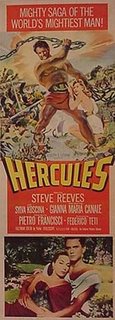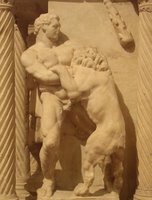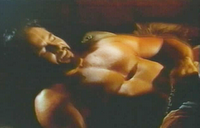
Portrait of Hercules. Pen and ink illustration in navy cloth covered library book. The picture is accompanying an abridged version of his biography. He reclines luxuriously upon a bearskin rug, sitting before a fire. He wears a lion skin tunic of thick dark fur. His muscular arms and legs are left uncovered. His handsome smile wears a beard. Many women surround him and enchant him with dances. I believe there was wine available to him as well as fruits.
A portrait of power and strength. He is the iconic independent, self-made man who relishes meeting challenges. He is a role model unto the cult of the masculine. In Greek mythology, Hercules was a divine/super hero: the son of Zeus/Jupiter. He was the greatest of the Greek heroes and a paragon of masculinity. According to the generally accepted accounts of his life, he’s a lot like Superman: half mortal, half immortal. Seeking adventure and righting wrongs. However, his background has darker moments. His prime directive, kill or be killed, challenges him mentally as well as physically. In storytellings, these darker elements are usually passed over in favor of glorifying his heroic accomplishments and virtuous, masculine ways.
 Steve Reeves does excellent work in a short tunic portraying the classic Greek hero in two Italian productions from the late fifties. Hercules (1958) directed by Pietro Francisci, became an international success due to Reeve’s commanding presence, good looks, mesmerizing physique and handsome smile. Francisci promptly followed it with Hercules Unchained in 1959.
Steve Reeves does excellent work in a short tunic portraying the classic Greek hero in two Italian productions from the late fifties. Hercules (1958) directed by Pietro Francisci, became an international success due to Reeve’s commanding presence, good looks, mesmerizing physique and handsome smile. Francisci promptly followed it with Hercules Unchained in 1959.Hercules’ script draws from the tale of Jason and the Argonauts. The role of Hercules is expanded, and elements of his twelve labors as well as his future wife Iole are included. It is worth noting that for the film, Hercules' youthful companion Hylas is replaced by the young Ulysses as a traveling comapnion/sidekick.
Both films are beautifully photographed in breathtaking Mediterranean landscapes. Crashing waves on windswept beaches provide dramatic background for the mythic characters. Chariots pulled by horses, boats with sails, open arenas and other outdoor environments recreate a sense of what it must have been like to have lived among a scantily clad peoples. The actors and actresses radiate a healthful tan from the long hours spent shooting out in full sun.
The interior scenes are subtly colorful and lightly mysterious, a pleasant counterpoint to the exterior scenes. The lighting is done well. The music is good. The opening titles are good. It’s all good, but truly, it is Steve that makes it great. He’s got the look. He’s got the arms. The glare reflecting from his oiled biceps can become overpowering at times. Polarized filters may be useless against their strength. They fill the screen with white flickering immortality. Steve Reeves is Hercules transmogrified. He is channeling Hercules. He has Hercules within him. He isn’t just acting.
 Reeves probably was Hercules in a previous life. Just look at him. Reeves was in the army and fought in a war. Hercules joined an army, he fought in a war.
Reeves probably was Hercules in a previous life. Just look at him. Reeves was in the army and fought in a war. Hercules joined an army, he fought in a war.Hercules fought a lion. Steve Reeves could have fought a lion if he wanted to.
Reeves became half immortal through his work. Hercules’ work did become a movie. All coincidence?
Hercureeves can out-fight or out-wit any man. When strength alone is not enough to win the battle, he is not above using deceit or trickery, such as when he tricked Atlas to take the world back upon his shoulders. He will only do so in the best interests of all, to enact justice. He helps children cross streams. He kills animals with his hands. He wins Olympic competitions. He stops wild horses. He chases girls. And while he does it, he looks fabulous.
 The costumes Reeves wears are to die for. His lion skin is scientifically cut to feature Reeve’s best assets: his well-defined v-shaped profile. His hemline is cut scandalously short. He wears his tunics one-shouldered, with robust pectorals. Belted at the waist with a thick leather WWF style championship belt. At his wrists, a pair of thick leather wristbands to match. At his feet, a strappy sandal: dark brown straps wrapped up to the mid-calf. With his dark hair and trimmed beard framing his handsome face, standing tall in his clean, well-pumped body, Hercureeves is devastating.
The costumes Reeves wears are to die for. His lion skin is scientifically cut to feature Reeve’s best assets: his well-defined v-shaped profile. His hemline is cut scandalously short. He wears his tunics one-shouldered, with robust pectorals. Belted at the waist with a thick leather WWF style championship belt. At his wrists, a pair of thick leather wristbands to match. At his feet, a strappy sandal: dark brown straps wrapped up to the mid-calf. With his dark hair and trimmed beard framing his handsome face, standing tall in his clean, well-pumped body, Hercureeves is devastating.In a battle scene from Hercules Unchained, he wears a dynamic style of tighty-whities - something that might be a one piece of cloth wraparound trick, yet skillfully constructed in the costume department. In keeping with previous costumes, it is quite minimal. He wears this in a spectacular battle scene wherein he takes on many men and swords in a scene so gloriously triumphant it is beyond the power of words to relate.
When he’s out exercising with the local boys, he wears a comfortable style of active sport tunic miniskirt, split in the front for easy mobility during manly activities. All the boys are wearing one. Of course, these sport tunics are a contrivance of propriety, as historical accuracy information suggests that Athenian guys exercised unclothed. This lack of historical accuracy is the one lamentable travesty of the film, as in that it lacks any full frontal views of Steve Reeves.
When some of the secondary characters go swimming, the swimsuits seem so inappropriate. Greek gods and demigods and mortals didn’t wear swimsuits on summer afternoons. But for the purposes of film, the designs of the outfits are charming and do complement the actors. These discreet outfits dress the story with a prudish niceness to portray a tame rendition of the sometimes adult-situational instances.
 According to legend it is said that in his early youth, Hercules killed his music tutor with a lyre. As punishment, he was sent to tend cattle on a mountainside. Here, he was visited by two nymphs: Pleasure and Virtue. They offered him a choice between a pleasant and easy life, or a severe but glorious life. He chose the latter. One of Hercules' first challenges was put to him by King Thespius who wished him to impregnate each of his 50 daughters. Accordingly, Hercules did this in one night.
According to legend it is said that in his early youth, Hercules killed his music tutor with a lyre. As punishment, he was sent to tend cattle on a mountainside. Here, he was visited by two nymphs: Pleasure and Virtue. They offered him a choice between a pleasant and easy life, or a severe but glorious life. He chose the latter. One of Hercules' first challenges was put to him by King Thespius who wished him to impregnate each of his 50 daughters. Accordingly, Hercules did this in one night.The path to the Twelve Labors started when Hercules married King Creon's daughter, Megara. Angered with him, Hera drove Hercules into a fit of madness during which he killed his wife Megara and their children, as well as his brother’s children. Upon realizing what he had done, he fled to the Oracle of Delphi. Unbeknownst to him, the Oracle was guided by Hera. As punishment, he was directed to serve Eurystheus, who had become king in Hercules’ place, and perform any task Eurystheus required of him. These challenges became the Twelve Labors, a tale which achieved notoriety and infamy as Hercules was able to successfully complete them all. Particular tasks, such as the killing of the Nemean Lion, are closely associated and therefore frequently included in stories about Hercules.
 Reeves wrestled that lion and wore the skin deliciously. For so many, appetites for musclemen with sword and sandal had increased. Fortunately, Italian film studios were productive throughout the mid-sixties. There are many, many enjoyable Hercules-oriented movies available, and they will always be there for you. Always and always.
Reeves wrestled that lion and wore the skin deliciously. For so many, appetites for musclemen with sword and sandal had increased. Fortunately, Italian film studios were productive throughout the mid-sixties. There are many, many enjoyable Hercules-oriented movies available, and they will always be there for you. Always and always.An additional title for those interested in seeing more: Giant of Marathon, 1959. Directed by Jacques Tourneur and Mario Bava, featuring Steve Reeves as Phillipides. Pheidippides, hero of Ancient Greece, is sometimes written as Phidippides or Philippidesis. His myth is said to be the inspiration for the creation of the marathon as a sporting event. Pheidippides, an Athenian herald, ran thirty-four kilometers in two days from the battlefield by the town of Marathon to Athens to announce the Greek victory over Persia in the Battle of Marathon, in 490 BC. Upon delivering the message, it is said he then died on the spot.
Giant of Marathon opens at an Olympic Games ceremony, where we are introduced to Phillipireeves. Apparently he is the winner of everything. He is given a medal and laurel wreath and an appreciative audience. His admirers in the audience call for him to become a leader of politics or military endeavors of some type, and when he accepts, the storyline deviates heavily from the above-stated tale regarding Phidippides.
The most striking difference between Reeves as Hercules and Phillipides is that Hercules is bearded, whereas the Giant of Marathon was clean shaven. Unbearded.
Phillipireeves becomes enchanted by women and is exposed to situations similar to that of Hercules. Fires burn as fountains flow and women dance with lips upon flutes and strumming upon harps. Drinks are not love potions, the women joke. Wrestlers are brought in for entertainment, but Phillipireeves objects. “I do enjoy wrestling, but these are no wrestlers. These are killers, no better than animals.”
 To prove his point, a struggle of Freudian proportions begins. Phillipireeves grapples with the killer-wrestler. As with the Nemean Lion, one must kill or be killed, in bare hand to hand combat. Muscles tighten, sweat drips. His arms wrapped around the huge belly, the muscleman dominates and subjectifies his opponent into submission. The agonizing contortions of exertion and release cross the face of the aggressor, his prey is left limp and akimbo upon the cold sticky ground. Phillipireeves slowly rises, finds his cape, and tosses it over his shoulder as he casually walks away. He would have smoked a cigarette if he had one.
To prove his point, a struggle of Freudian proportions begins. Phillipireeves grapples with the killer-wrestler. As with the Nemean Lion, one must kill or be killed, in bare hand to hand combat. Muscles tighten, sweat drips. His arms wrapped around the huge belly, the muscleman dominates and subjectifies his opponent into submission. The agonizing contortions of exertion and release cross the face of the aggressor, his prey is left limp and akimbo upon the cold sticky ground. Phillipireeves slowly rises, finds his cape, and tosses it over his shoulder as he casually walks away. He would have smoked a cigarette if he had one. Later, he’s at the gymnasium with the guys. We find out that most all of them wear these sport tighty-whities for these action shots. Their tunics are pretty short. Then they are recruited to become sailors and go with Jason to find the Golden Fleece, and again I am confused. They fight a sea-battle, and at the end of it I am ready to see Phillipireeves run his ass off and show up in Athens exhausted and spent. But instead, he ‘gets the girl’ and walks away into a sunset. The film fails to account for the story of the Giant of Marathon, but it excels on featuring the many fine points and curves of Steve Reeves.
Later, he’s at the gymnasium with the guys. We find out that most all of them wear these sport tighty-whities for these action shots. Their tunics are pretty short. Then they are recruited to become sailors and go with Jason to find the Golden Fleece, and again I am confused. They fight a sea-battle, and at the end of it I am ready to see Phillipireeves run his ass off and show up in Athens exhausted and spent. But instead, he ‘gets the girl’ and walks away into a sunset. The film fails to account for the story of the Giant of Marathon, but it excels on featuring the many fine points and curves of Steve Reeves.For the completist, here is a short list of additional Herculeses:
Hercules, 1983, film starring Lou Ferrigno
Hercules, 1997, film the Disney movie
Hercules, 2005, an NBC television movie
Hercules in New York, 1969, Arnold Schwarzenegger's film debut
Hercules: The Animated Series, based on the Disney movie
Hercules: The Legendary Journeys, TV-series
The Mighty Hercules, 1963 animated television series
The Sons of Hercules, 1970s television series from Italian films
And a tribute to the Hercules of today: Eli Manning, Tom Brady, Andre Agassi, Roger Federer, Henry Rollins, Hulk Hogan, Johnny Knoxville, Tony Hawk, Bruce Willis, Shaquille O’Neal, Mr. T, Barry Bonds, Bill Gates, police and firefighters everywhere.








.jpg)






2 comments:
Very funny. I think I like your account better than Robert Graves'.
Yes, but how was Reeve's physique?
Post a Comment